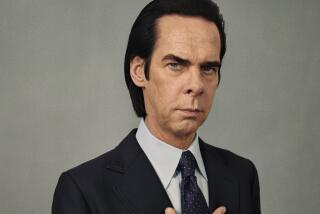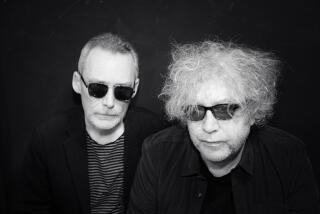HAYWARD SINGS THE BLUES’ PRAISES
Justin Hayward is the most gracious dinosaur around.
At 39, the Moody Blues’ singer-guitarist is getting a bit old for rock ‘n’ roll and he knows it. But conversations about age don’t rile Hayward, who is bright, articulate and unnervingly calm. Dinosaur rockers are usually uneasy with discussions about dinosaur rock, which is music by bands from the ‘60s and early ‘70s that have managed to survive and remain popular. But the subject just makes Hayward smile.
“I can’t really get upset when we’re called dinosaurs,” he said. “Sure we’re getting old. We’re probably some of the things they say we are. But we can still function in this business. We’re proud that we can still have hits. It’s tougher for us than it is for younger bands.”
Compared to the bulk of musicians in the record business, who are in their teens and 20s, these guys are codgers. Hayward is the youngest of the lot. Bassist John Lodge, drummer Graeme Edge, flutist Ray Thomas and keyboards player Patrick Moraz are in their early ‘40s.
But age has merely sharpened their pop skills. Their commercial sense, something that often fades with age, is still strong. Their current album, “The Other Side of Life,” and one of its singles, “Your Wildest Dreams,” both were recently in Billboard’s pop Top 10.
On the strength of these hits, the British quintet has suddenly become a hot touring act. Quite a few dates have been added throughout the current tour. The local dates are Aug. 28, 29 and Sept. 2 at the Universal Amphitheater and Aug. 30 at the Pacific Amphitheater.
Musically, the Moodies have toned down considerably. Back in the old days, their music was infested with pomp and grandeur. Songs like “Nights in White Satin” and “Tuesday Afternoon” were flowery, cosmic melodramas. Often the music was closer to classical than rock ‘n’ roll.
But those pretentions have been scuttled. The band, though, has salvaged the most appealing features of it music--the pretty melodies, the complex vocal arrangements and that elegant, symphonic feel. Much of “The Other Side of Life” is pompous pop, but several of the songs are catchy and commercial.
Overall, the band did a creditable job on the album. Not bad for dinosaurs.
No band lasts this long without suffering through some severe lows. The Moodies, formed in England in 1964, hit the ultimate low a decade later: They split up.
“We needed time apart,” Hayward recalled. “Everybody needed to do something different. We kind of drifted apart. Within three months of the breakup, we knew we were going to get back together, even though it turned out to be two years later.
“Fortunately, there was no big fight. Sometimes when bands break up, things are said that you can’t take back. But we didn’t say any of those things. Even when we split up, we did it in the friendliest way possible.”
Lack of success certainly wasn’t a factor in the split. “We just had two No. 1 albums, ‘The Seventh Sojourn’ and ‘Days of Future Passed,’ ” Hayward recalled. “At the time, I thought we were crazy. But things had to happen that way. Luckily, we survived it.”
The band battled through another crisis much more recently. Its previous album, “The Present” (1983), was a failure. “It was too inward-looking,” Hayward suggested. “We spent a lot of time fiddling with bits of recording that no one would ever hear. The album before that one, ‘Long Distance Voyager,’ had been No. 1. We didn’t want to make another ‘Long Distance Voyager,’ but we weren’t sure what kind of album we did want to make.”
Back in 1983, some people were predicting the demise of the Moodies. Many industry observers felt that “Long Distance Voyager” (1981), the album that launched their big comeback, had been a fluke. The consensus was that the band couldn’t really come back after the flop of “The Present.”
But the Moodies had heard bleak forecasts before. “Whenever we’ve faltered on an album, people have written us off,” Hayward explained. “As we get older, they figure we have less of a chance of coming back. But we keep proving them wrong.”
The key to the latest comeback was a new producer. They hired Tony Visconti, who has worked with David Bowie, to produce “The Other Side of Life.” “He chose the material,” Hayward explained. “He’s also a musician and an engineer. He was able to do many things. We were able to cut down on the number of people working on the album. We streamlined things in general.
“There were some big musical changes on this album. There was more emphasis on drums, bass and guitar. The music was harder and punchier. We wanted to create more space in our sound this time. We wanted to make the music more accessible to a lot more people.”
The Moodies certainly are consistent. Most of the members have been with the band since it was formed back in the mid-’60s. Only keyboards player Patrick Moraz, who replaced Mike Pinder in 1978, is not an original member.
What’s the secret of their longevity?
“For one thing, we’re all very different personalities,” Hayward replied. “No one overlaps emotionally or professionally into someone else’s territory. Our personalities complement each other. We don’t have people who are a lot alike. Those are the people who can’t get along.
“We really are like a family. The feeling between us is very strong. It’s hard for someone to come between us. Even when we split up for a few years, it was amicable. We stayed in touch. For a band to last as long as we have, you really need this kind of feeling.”
Another factor, Hayward noted, was modifying their intensity: “I’m less intense about my ambitions now. We all are. When you’re young, you’re fighting and striving and pushing people out of the way. You just want to get to the end of that rainbow and grab some of the riches.
“But the struggle isn’t so intense now. We’re still striving but we do it differently. Things are calmer. We’re not brought down by the failures as much as we used to be. Also, we’ve built up this incredible confidence. We’ve come back so many times that we know we can overcome just about any problem. We have this feeling that we can go on forever.”
More to Read
The biggest entertainment stories
Get our big stories about Hollywood, film, television, music, arts, culture and more right in your inbox as soon as they publish.
You may occasionally receive promotional content from the Los Angeles Times.










